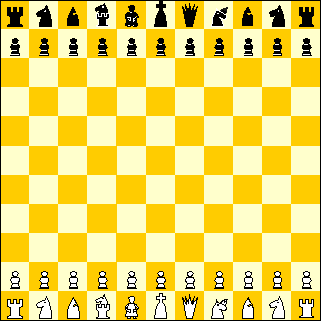 White:
White:King f1; Queen g1; General e1; Marshall d1; Adjudant h1; Rook a1, k1; Knight b1, j1; Bishop c1, i1; Pawn a2, b2, c2, d2, e2, f2, g2, h2, i2, j2, k2.

John Gollon, well known by chess variant enthousiasts for his book on chess variants, now unfortunately out of print, was working on a second book on chess variants. Also unfortunately, this second book was never published. Gollon has sent some materials from a draft of the book to Eric Greenwood (in 1976): the description given here is based on part of these writings by Gollon.
This game was invented by L. Tressan of Leipzig in 1840.
The game is played on an 11 by 11 board. With the usual set of pieces, three additional pawns and three new pieces: a general and an adjudant are given to the players. The game starts with the following opening setup:
 White:
White:
King f1; Queen g1; General e1; Marshall d1; Adjudant h1; Rook a1, k1; Knight
b1, j1; Bishop c1, i1; Pawn a2, b2, c2, d2, e2, f2, g2, h2, i2, j2, k2.
Black:
King f10; Queen g10; General e10; Marshall d10; Adjudant h10; Rook a10,
k10; Knight b10, j10; Bishop c10, i10; Pawn a9, b9, c9, d9, e9, f9, g9,
h9, i9, j9, k9.
The general has the combined moves of queen and knight; i.e., it can move as rook, bishop, or knight.
The adjudant has the combined moves of bishop and knight.
The marshall has the combined moves of rook and knight.
Pawns may make at their first movement a triple or double step (or a normal single step movement), so a white pawn on e2 can move to e3, e4, or e5 (or capture at d3 or f3). At each of the squares passed by, the pawn can be taken en passant. Pawns can promote to general, queen, adjudant, marshall, rook, knight, or bishop. In Tressan's other game The Emperor's Game, pawns could only promote to lost pieces, so this rule may well be also the case here.
A player can castle under the same conditions as orthodox chess. When castling, both the rook and the king move four squares in each others directions (thus rook and king do not end up at adjacent positions after castling.)
Other rules are as in orthodox chess.